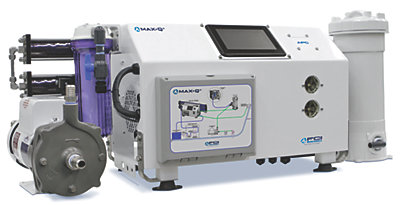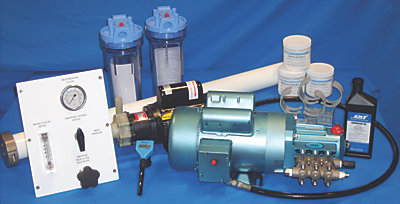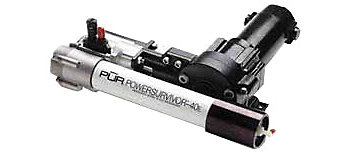Choosing a Watermaker
 What boater hasn't dreamed of having an endless supply of fresh water on board – especially when the water tanks are getting a little low and the nearest fresh water source is a day away? The design of watermakers has come a long way in the last decade – providing more water for less power. They can extend your travel range and ensure that you always have a safe water supply onboard – making them a welcome addition to any boat. If you've got extra space on your boat and are thinking about adding a watermaker – this Fisheries Navigator will cover some important points to consider before you buy. But first – let's talk a little more about how a watermaker performs this magic!
What boater hasn't dreamed of having an endless supply of fresh water on board – especially when the water tanks are getting a little low and the nearest fresh water source is a day away? The design of watermakers has come a long way in the last decade – providing more water for less power. They can extend your travel range and ensure that you always have a safe water supply onboard – making them a welcome addition to any boat. If you've got extra space on your boat and are thinking about adding a watermaker – this Fisheries Navigator will cover some important points to consider before you buy. But first – let's talk a little more about how a watermaker performs this magic!
Reverse Osmosis
Watermakers use a process called reverse osmosis to produce fresh water. This happens by using a high pressure pump to force salt water through a semi-permeable membrane which lets fresh water molecules through, but keeps other larger contaminants like salt, bacteria, minerals and organisms out. The leftover “brine” is then discharged overboard while the pure fresh water is diverted into your water tank. Low temperatures or high water salinity can cause a significant decrease in the actual output of the unit – so make sure to take your cruising environment into consideration when reading through the manufacturer's specifications. It's also extremely important to follow the manufacturer's directions for usage and to make sure you preform a fresh water flush after every use with chlorine-free water. Curious to see exactly how good the water you are making is? Most units now come with a TDS (total dissolved solids) meter built in – but if not you can purchase one to check the quality of the water before putting it in your tank.
 How much water do you need?
How much water do you need?
Now that you've decided to add a watermaker, the first thing you need to figure out is how much water you use onboard on a daily basis. Try to estimate how much water you use for everything on your boat – including water for drinking, cooking, washing dishes, cleaning your hands, showering and doing laundry. Once you've got your number – multiply it by how many people will be onboard and you should have a good idea of how much water you will be using on a daily basis. It's important to note that the amount of water you use can be highly influenced by the climate you are in and the activities you enjoy while boating.
We should also point out that most manufacturers calculate their unit's output in gallons per day – so you'll need to convert that to hours to see if the unit will accommodate your needs since it's highly unlikely you'll be running it 24/7.
What is your cruising profile?

Most modern units offer electronics that automatically perform a fresh water flush after use or inactivity – while some require the manual manipulation of valves – so you need to ask yourself if you want control or if you prefer the unit do all the work. If you are the kind of cruiser who likes to "set it and forget it" then the fully electronic option is definitely the way to go.
How will you power your watermaker?
Another major point to consider is what your options for powering the unit are. Watermakers come in three different types – DC, AC or engine driven – all of which have their own pros and cons.
- DC (12 Volt) watermakers usually operate with lower amperage draws – making them a great option for smaller boats, or for boaters who want to use solar or wind energy to power their watermaker. The downside is that they produce less water per hour than AC or engine driven units so you'll need to run them for considerably longer to produce the same amount of water.
- AC (110 Volt) watermakers need either a generator or a large inverter with a high output alternator (if using your motor) to operate – but they make a lot of water per hour, so the run time will be significantly lower. For boaters who regularly run a generator, this is a great option as it can add load while filling your water tanks – a win/win.
- Engine driven watermakers can make water anytime you are running your engine – making this an interesting option as most of us run our engines fairly regularly. The downside is that while they can produce a lot of water, they can be complicated to install and unless you are a mechanic you'll need to consult with one to make sure it's a viable option for your boat before proceeding.
What about replacement parts?

You should also consider how easy is it to service the watermaker and its pre-filters before making your choice. Most modern watermakers have incorporated fresh water flushing and water testing – a great addition – but make sure you can still access the areas that need to be serviced after the unit is installed. This is especially important as manufacturers move to more “enclosed” style units over modular designs.
Once you've taken a look at all of this, you should be ready to move forward and make a purchase. Fisheries Supply is proud to offer several brands of watermakers for a variety of needs – including FCI, Katadyn and US Watermaker. We hope you've found this overview on buying a watermaker helpful – but if you have any additional questions, please don't hesitate to contact our product experts at (800) 426-6930.